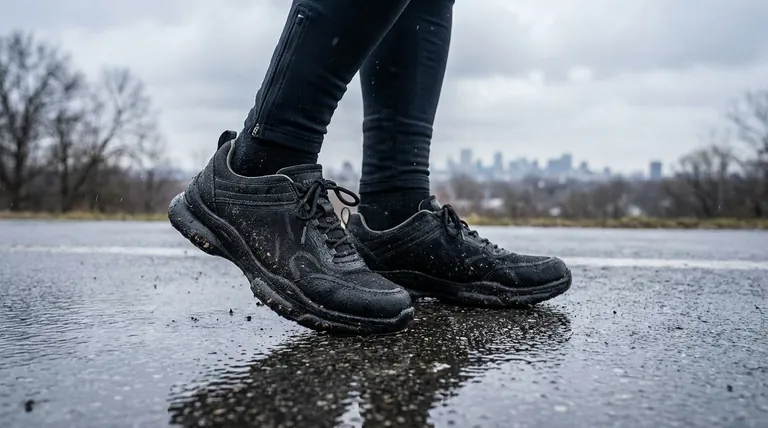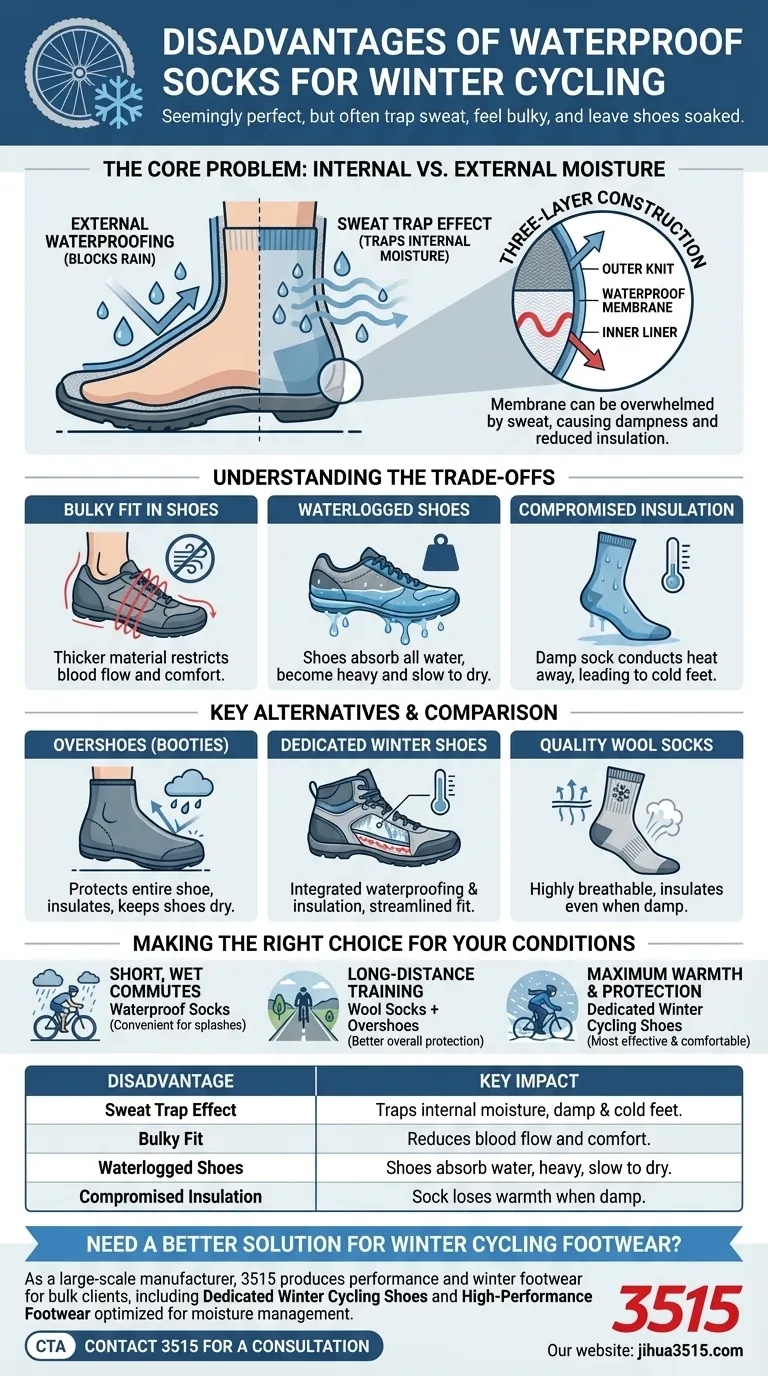While seemingly a perfect solution for wet rides, the main disadvantages of waterproof socks for winter cycling are their tendency to trap sweat, their bulky feel in performance shoes, and the fact that they leave your cycling shoes completely soaked and heavy. They solve one problem—water getting in—but can create another by preventing moisture from getting out.
The core issue with waterproof socks is the trade-off between external waterproofing and internal breathability. While they block rain and spray effectively, they struggle to vent the significant amount of sweat produced during cycling, which can leave your feet damp and cold from the inside out.

The Core Problem: Internal vs. External Moisture
To understand the drawbacks, you first have to understand how these socks work and the two-front war your feet fight in winter: against water from the outside and sweat from the inside.
How Waterproof Socks Are Constructed
Most waterproof socks use a three-layer system. They have a durable outer knit layer, a soft inner liner for comfort, and a waterproof, breathable membrane sandwiched between them. This membrane is what stops water from getting through.
The Sweat Trap Effect
The term "breathable" is relative. While the membrane allows some water vapor to escape, it can be easily overwhelmed by the amount of sweat your feet produce during high-exertion activities like cycling.
When this happens, the sweat vapor condenses inside the sock. Your foot becomes damp, defeating the primary purpose of staying dry and warm.
Compromised Insulation When Damp
Once your foot is damp from trapped sweat, the insulating properties of the sock's inner liner are significantly reduced. Water conducts heat away from the body far more effectively than air, so a wet foot will quickly become a cold foot, even if it's protected from outside rain.
Understanding the Trade-offs
Waterproof socks aren't inherently bad; they are a specific tool with a distinct set of compromises compared to other winter cycling solutions.
The Bulky Fit in Cycling Shoes
The three-layer construction makes waterproof socks thicker than standard cycling socks. In snug-fitting performance shoes, this extra bulk can compress your foot.
This tightness not only feels uncomfortable but can also restrict blood flow, which is critical for keeping your extremities warm. It also eliminates the layer of air needed for effective insulation.
The Waterlogged Shoe Problem
This is a major, often overlooked disadvantage. While your feet may stay relatively dry from road spray, your shoes do not. They absorb all the water.
This leaves you with heavy, cold, waterlogged shoes that can take days to dry out, making them miserable to put on for your next ride.
The Case for Waterproof Socks
Despite these drawbacks, they have their place. They are more affordable than dedicated winter shoes and easier to put on than many overshoes. For shorter, less intense rides in wet weather, they can be a convenient and effective option.
Key Alternatives and How They Compare
Understanding the alternatives helps clarify where waterproof socks fall short.
Overshoes (Booties)
This is the classic solution. A good waterproof and windproof overshoe protects the entire shoe. This keeps your shoes dry, clean, and adds a significant layer of insulation against cold wind. They directly solve the "waterlogged shoe" problem.
Dedicated Winter Cycling Shoes
For serious winter riders, this is the premium solution. These shoes integrate a waterproof membrane (like Gore-Tex) and insulation directly into their construction. They offer the best combination of warmth, water protection, and a streamlined fit without the bulk of extra layers.
Quality Wool Socks
In cold but dry conditions, a high-quality merino wool sock is often superior. Wool is highly breathable and, crucially, insulates even when damp. This means that if your feet do sweat, you will remain warmer than you would in a synthetic sock that has gotten wet from trapped perspiration.
Making the Right Choice for Your Conditions
Your ideal solution depends entirely on your riding style, duration, and the specific weather you face.
- If your primary focus is short, wet commutes: Waterproof socks can be a convenient and affordable solution to keep your feet dry from splashes.
- If your primary focus is long-distance winter training: A combination of quality wool socks and waterproof overshoes offers better overall protection for both your feet and your equipment.
- If your primary focus is maximum warmth in severe cold and wet: Dedicated winter cycling shoes are the most effective, albeit most expensive, investment for performance and comfort.
Ultimately, the best system is one that effectively manages both the water trying to get in and the sweat trying to get out.
Summary Table:
| Disadvantage | Key Impact |
|---|---|
| Sweat Trap Effect | Traps internal moisture, making feet damp and cold from sweat. |
| Bulky Fit | Reduces blood flow and comfort in snug cycling shoes. |
| Waterlogged Shoes | Shoes absorb all external water, becoming heavy and slow to dry. |
| Compromised Insulation | Sock loses warmth when damp from trapped sweat. |
Need a better solution for winter cycling footwear?
As a large-scale manufacturer, 3515 produces a comprehensive range of performance and winter footwear for distributors, brand owners, and bulk clients. Our production capabilities encompass all types of shoes and boots designed for comfort, durability, and protection in harsh conditions.
We can help you provide:
- Dedicated Winter Cycling Shoes: Integrated waterproofing and insulation without the bulk.
- High-Performance Footwear: Optimized for breathability and moisture management.
Let's discuss how we can manufacture the right footwear solution for your customers' needs.
Contact 3515 today for a consultation
Visual Guide

Related Products
- Wholesale Breathable Training Shoes Custom Athletic Footwear Manufacturer
- Safety Footwear Wholesale Manufacturer for Custom OEM/ODM Production
- Durable Rubber-Soled Utility Shoes for Wholesale & Custom Brand Manufacturing
- Wholesale Training Shoes with Dial Lacing System Custom OEM Manufacturing
- Lightweight Breathable Sneakers with Wet-Traction Grip for Wholesale & Private Label
People Also Ask
- What are the characteristics of canvas as a shoe material? A Guide to Lightweight, Breathable Footwear
- Why are running shoes and walking shoes not interchangeable? Avoid Injury with the Right Footwear
- What are the benefits of breathable mesh in shoe design? Enhance Comfort and Performance
- Does more ground contact area mean better support? Unlock the Secrets of Stable Footwear
- How do non-slip athletic shoes differ from regular athletic shoes? Discover the Grip Technology



















